Villiers Australia Pty. Ltd.

Villiers Australia Pty. Ltd. was setup in 1953 by none other than Frank H. Farrer himself, but we need to explore the reasons why Frank come to Australia and what issues
the Australian Government’s restrictions of early 1951 placed upon Villiers powered industrial and agricultural machinery manufacturers in Australia and what it meant to Villiers Engineering Co. in Wolverhampton.
Basically the embargo meant that Villiers Engineering could no longer export engines to Australia even though they had just spent £600,000 retooling their Wolverhampton workshops to cope with the demands of Australian orders for Villiers products in 1953 and 1954, this all came to a grinding halt until the number one man, Frank Farrer came down under to Australia to sort it all out and put Villiers Engineering back on track.
Villiers Arrives in Australia
The following articles have been compiled from Trove about Villiers Engineering Co. Ltd. and setting up Villiers Australia Pty. Ltd. in Ballarat.
January 1953
Villiers Chief to Visit Here
The Age – 26 January 1953
The chairman of directors of The Villiers Engineering Co. Ltd., Wolverhampton, England (Mr Frank H. Farrer) will visit Australia early next month.
He will arrive in Sydney by air on February 9 and is expected to be in Australia for about four weeks.
Mr Farrer will spend most of his time in Sydney and Melbourne.
The company makes light internal combustion engines, free-wheels, magnetos and carburettors.
Director plans business visit
The Sun – 27 January 1953
Arrangements to visit Australia have been completed by Mr Frank H. Farrer chairman of directors of the Villiers Engineering Company Ltd., Wolverhampton, England.
He will leave South Africa on February 6 and arrive in Sydney on February 9.
He expects to be in Australia for about four weeks and will make Sydney his headquarters.
He hopes to visit as many of the capital cities as possible but most of his time will be spent in Melbourne and Sydney.
February 1953
Plans to build Australian Engine
News – 2 February 1953
Negotiations for the manufacture of Villiers engines in Australia are to be undertaken this month by Mr. Frank H. Farrer, chairman of directors of Villiers Engineering Co. Ltd., Wolverhampton, England.
Mr Farrer is flying from South Africa this week. He will visit Adelaide on February 26 for a few days.
The company built its repuation and business with the noted motor cycle engines.
It is now a major producer of small air-cooled engines from 1/2 to 4 h.p., with a wide variety of industrial and domenestic uses.
‘Valued’ Industry
Villiers power units are built into minature cars, including the Bond Mini-car and the AC Petite. A representative of BTM Agencies Pty. Ltd., Adelaide representatives of Villiers Engineering Co. Ltd., said Mr. Farrer would spend four weeks in Australia, chiefly in the Eastern States.
Manufacture of its engines in Australia would be a valuable new industry with far-reaching benefits.
Villiers To Build Engines in Australia
Barrier Daily Truth – 11 February 1953
Sydney, February 9 – The Villiers Engineering Co. of Wolverhampton, England, will manufacture small combustion engines in Sydney.
The chairman of the company Frank H. Farrer, arrived in Sydney today to select a site for the works. He said the firm had £600,000 worth of new machinery installed to cope with Australian orders for 1953 and 1954.
Then the import restrictions came into force. I have decided the solution is to bring the machinery to Australia provided labor will give a good day’s work for a good day’s pay he said.
April 1953
Big Factory for Ballarat
The Herald – 1 April 1953
Tenders would be called within a fortnight for the first section of the big factory to be erected by Villiers Engineering co. on the Ballarat Common, the Premier, Mr Cain, said today.
Mr Cain said the initial capital of the company would be £250,000 and it would soon be giving employment to about 400 men. Various sections of the new factory would carry out high precision engineering. ferrous and non-ferous foundry work, sheet metal work and dimond grinding.
The company’s famous two-stroke engines would be turned out at the Ballarat factory. Nearly 20 types of engines were made by the company.
It would start operations on engines for milking machines, pumping plants and other aids to primary production.
The new company, Mr Cain said had taken over 20 acres of the 300 acre Ballarat Common which had been reserved for de-centralised industries. It was hoped to get 50 or 60 industries on the area. It was already served with electricity and high pressure gas mains for industries which were being extended there.
Mr Cain said the founder and chairman of directors of Villiers Engineering Company, MR Frank H. Farrer was greatly impressed with the possibilities in Victoria. He had come to Australia to correct the effect of import restrictions on the company’s business.
Ballarat will export motors
The Argus – 14 April 1953
Villiers Engineering Co., of England, plan to manufacture engines for export at its new Ballarat Factory, Mr Stoneham, Minister for State Development said yesterday.
Mr Stoneham said the engines would go to New Zealand, India, Pakistan, the East Indies, and Japan as well as to the Australian market.
Work has now started on a building to assemble two and four stroke Villiers engines.
Mr Stoneham said negotiations were proceeding with a big Australian firm for another area on the Common and it was likely that other industries would seek sites there soon.
Villiers to Start Today
The Age – 13 April 1953
Work will start today on a preliminary building on Ballarat Common for the English Villiers Engineering Company’s new factory.
This building will be used for the assembling of parts.
On competion of the main factory it will become the aluminium factory.
Tenders for construction of the main section, providing 25,000 square feet of space will be called within the next month.
The factory will make two-stroke engines.
Villiers Plan at Ballarat
The Age – 14 April 1953
Victoria will be able to export agricultural engines to Asia as a result of the erection of the factory at Ballarat by the Villiers Engineering Company of England.
The Minister for State Development (Mr. Stoneman) said yesterday that this was the ultimate aim of the company in establishing itself at Ballarat.
Mr Stoneham said that work had commenced on the erection of a factory for the assembly of engines.
Within two or three months, the company planned to build a larger factory to start actual production
Villiers Engineering big Ballarat plans
The Herald – 21 April 1953
Adelaide: An English engineering cmpany is establishing a motor industry in Australia because its products have been included in the Goverment’s emargo on imports.
Mr Frank H. Farrer, chairman of directors of Villiers Engineering Company Ltd., said this on his arrival in adelaide today. “We have started building the factory to cost £250,000 on 20 acres of land at Ballarat which is central for all our Australian markets” said Mr Farrer.
Small internal combustion engines for industrial and domestic uses will be built when manufacturing gets under way in about eight months.
June 1953
Villiers let BIG Contract
The Herald – 18 June 1953
The Villiers Engineering Co. Ltd.’s factory at Wendouree West Industrial section will be erected by the Lewis Construction Co. of Melbourne.
Buildings and equipment worth £250,000 will be set up on the site within the next six months. The company will manufacture its famous two-stroke engines.
July 1953
Vic. Factory For Engines
The Advertiser – 2 July 1953
Manufacturers of Villiers two-stroke engines, which power the majority of British lightweight motor cycles, are to form a subsidiary company in australia. The company to be know as Villiers Engineering (Pty.) ltd. will operate from a factory to be built on a 20-acre site at Ballarat, Victoria.
It is planned to start manufacture in about three months time, and to enable this to be done temporary buildings will be used for assembly of components imported from Wolverhampton, England. with the approval of the Commonwealth Goverment, while the main factory is under construction.
As the factory is completed more of the complete manufacture will be done there from local raw materials.
A number of specialists are going to Ballarat from the Wolverhampton factory to get things under way.
Building The Ballarat Factory – 1953
In 1953 Frank Farrer came to Australia to negotiate a deal with the Australian Government over the embargo that was placed on engines being exported to Australia in early 1951. The discussions and result that came from this was to setup shop in Australia and start building engines in Australia to service not only Australia but other parts of the world which include New Zealand, West Indies, Japan & Indonesia.
A lot of different locations were considered, but the location of Ballarat in Victoria, Australia was chosen.
A historic town, 116kms from Melbourne that was the result of a gold mining boom of the 1850s.
A 20 acre plot of land was chosen next to the main railway line in the suburb of Wendouree at 211 Gillies Street, on the corner of Gillies Street and Learmonth Road.

plot of land now is occupied by Isuzu Ute Ballarat, Ballarat Holden, Ballarat Skoda, Ballarat Audi, Wendouree Railway Station and Central Highlands Water.
In 1953 Frank Farrer met with local architect Herbert Leslie Coburn, a well known Ballarat architect. His work can still be seen around Ballarat today.
As the factory had to be built in stages, the first part was built which allowed engine parts to be exported to Australia from the Wolverhampton factory to be assembled as whole engines. This allowed the company a running start in Australia.
The whole process from start in 1953 to officially opening the factory took 4 years.
Douglas W. Ramsden, a former Major in the British Paratroopers who was secretary of Villiers Engineering Ltd. and member of the Villiers Engineering Ltd. board was asked to head the Australian operation.
Premier of Victoria Opens Villiers Australia Factory – 1957
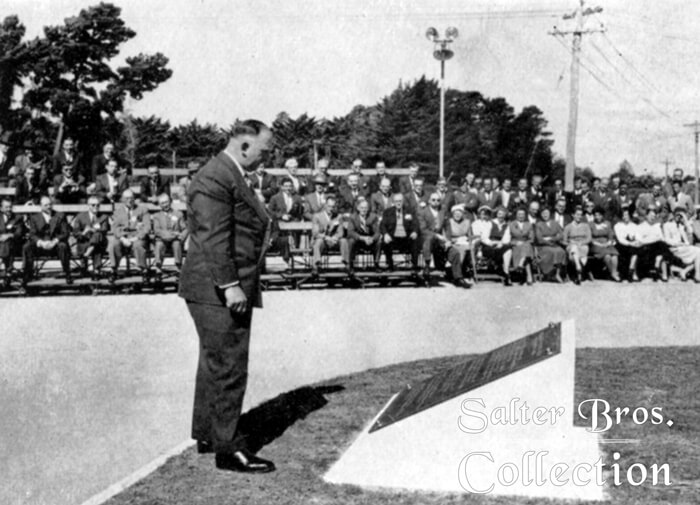
“Your company is a good one. It is not built on sand nor is it planning on sand. It will remain for generations of workers to come. You have almost blazed the trail for spectacular development in Ballaarat”.
Thus commented the Hon. H. C. Bolte, Premier of Victoria, when officially opening the Ballaarat factory of Villiers Australia Pty. Ltd. in December 1957.
A wholly owned subsidiary of The Villiers Engineering Co. Ltd., Villiers Australia Pty. Ltd. was founded in 1953 and production of engines commenced as soon as the first of the factory buildings was ready the following year.
Since then tremendous expansion hsa taken place to meet the ever-growing demand for Australian-built Villiers engines, and the opening ceremony followed the completion of the third stage in the development of the 20 acre site.
Left: Mr. Bolte pauses to read the inscription on the commorative plaque which he unveiled at the conclusion of the opening ceremony which the below picture shows him performing.
The ultimate aim is to make the factory as self sufficient as the parent company at Wolverhampton, but such has been the progress made to date that the output already approximates 10,000 engines per month.
Mr Bolte said Villiers had established themselves at Ballaarat because the man-hour output there could stand up to the closest scrutiny and was, in fact, higher than any metropolis. Climatic conditions, too, suited the industry. “Your success here”, he declared, “Is the best advertisement Ballaarat could have, and Ballaarat itself will have a great deal to thank you for”.
Although the opening ceremony was of symbolic nature, Mr Bolte said it could be regarded as far more than that. “Your plant”, he said, “has reached a stage where production, floor space and numbers are increasing almost weekly. You could almost have some sort of official opening every year”.
Referring to the current output of 10,000 engines a month, Mr. Bolte said: “Just think of the number of people being influenced by your productions, not only in agriculture and industry but also in the household sphere”.
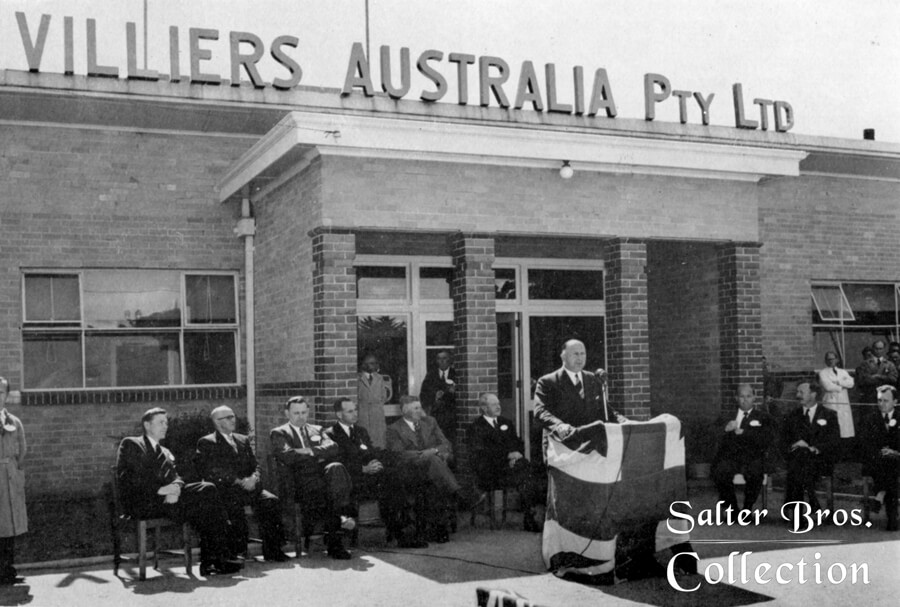
He congratulated the company on its enterprise and development and said he was pleased to be present to recognise the tremendous job Villiers was doing and the neet it was supplying.
Welcoming Mr Bolte and many other distinguished guests, Frank D. Spencer, joint managing director of Villiers Australia Pty. Ltd., said: “Australia is today witnessing a revolution. During the last ten years a tremendous growth of secondary industry has taken place, and whether we like it or not it will inevitably change the pattern of our lives.
The next decade will see the completion of this industrial revolution, and it will be one of the most critical periods in Australia’s history, for it is not enough for us simply to produce goods – we must of necessity produce them economically.
Our place in Asia and the free world is dependent upon this simple fact”.
Mr spencer said that Australians could not afford to be complacent about their ultimate success. The future was by no means as secure as far too many Australians thought.
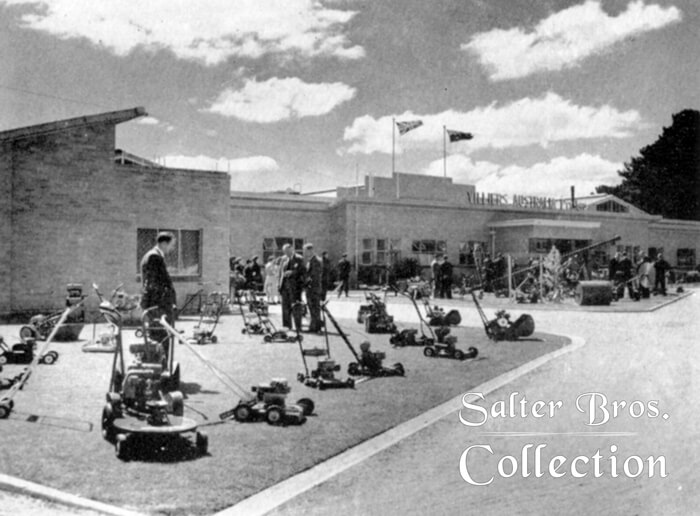
Various types of lawn mowers figured prominently in an impressive display of end-products powered by Villiers Engines. It was revealed that already nearly one hundred Australian manufacturers fit Villiers engines to their products.
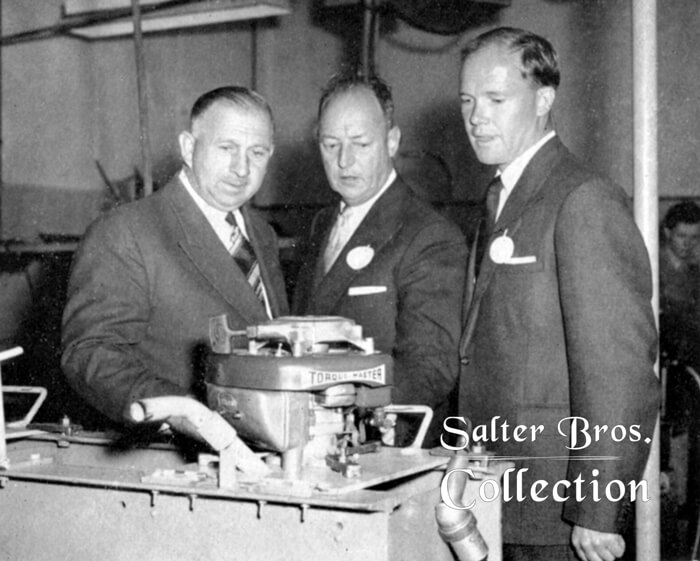
A tour of the works followed the opening ceremony, Frank D. Spencer (right) and W. B. Steen (center), joint managing directors of the Australian company are seen showing Mr Bolte a Torquemaster engine, known in England as the Mark 7F.
“However, ” he declared, “the gauntlet has been cast down and we at Villiers have sufficient faith in Australia to know that the challenge will be taken up by new and old Australians alike”.
Referring to the labour force of the factory, Mr Spencer revealed that 45 per cent were new Australians.
Australia, he said was richer for the presence of those newcomers, who had brought with them from the old world proven methods which were wonderful foundations on which to built industries such as theirs.
Thanking Mr Bolte for opening the factory, W. B. Steen, joint managing directory responsible for production, paid tribute to the Ballarat City officers and councillors for their invaluable assistance in establishing the plant in Ballarat.
At the completion of the ceremony Mr. Bolte unveiled a plaque commerating the occasion.
The plaque linked the names of Mr. Bolte and the late John Cain, Victoria’s labour Premier, with whom Frank H. Farrer, then chairman and now president of Villiers Engineering Co. Ltd., negotiated the project in 1953.
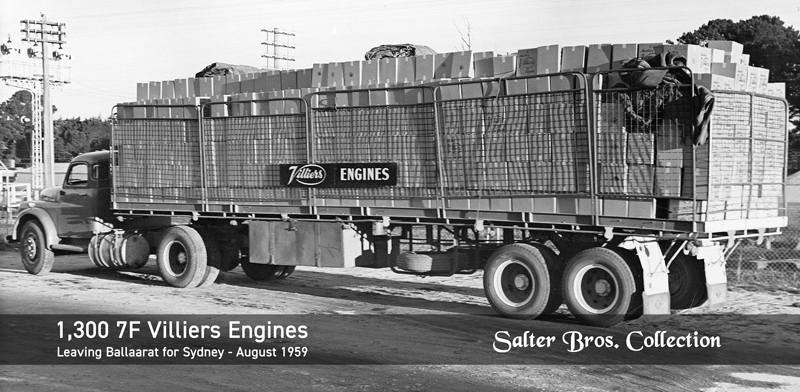
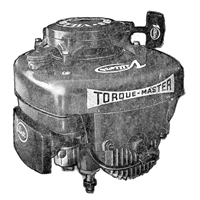
In August 1959 outside the Villiers Australia factory in Ballarat, Victoria, Australia sits a truck with 1,300, 7F Villiers Engines all hand loaded and almost ready to depart for Sydney, New South Wales, Australia.
These engines were bound for a lawn mower manufacturer to be put on lawn mowers.
Norton-Villiers
In 1966 the AMC Brand of Villiers Engineering went bankrupt and was taken over by Manganese Bronze Holdings which formed Norton-Villiers to oversee their operations.
At this time, the only company under their hat that was making money, was Norton.
Since its establishment, the plant has manufactured Villiers petrol engines for Australia and neighbouring markets.
This range was supplemented in 1971 when Merbank Corporation and Norton Villiers completed a deal to purchase the manufacturing rights of Wisconsin engines.
The Ronaldson & Tippett Foundry was purchased in in the above deal from Merbank Corporation and renamed Norvil Foundry.
Norvil is an amalgamation of the two words Norton and Villiers – NOR VIL.
The business was sold by the English Company in 1978 to the Australian Shareholders (Norton Villiers Australia Pty. Ltd.) and operated as an independent company in every way. In mid 1979 the decision was made to expand the Contract Engineering Division, and to discontinue the manufacture of engines.
The Company was appointed sole Australian distributors of Mitsubishi stationary engines in late 1979.
It is conveniently sited on a major trans-Australia rail line system, connecting all State capital cities. In addition, local, regional and national road transport companies (e.g. Brambles, T.N.T, IPEC, etc.) operate from Ballarat.
Quality control management systems have been independently assessed and found to meet the stringent demands of the automotive industry and government departments.
The company is a member of The Australian Standards Association, The Victorian Chamber of Manufacturers, The Institute of British Foundrymen (Aust.), and the Australian Union of S.G. Iron Producers Association. Its organisation is equipped to assure the total responsibility for large manufacturing contracts.
Specialist services such as electrical engineering.contracting and N.A.T.A.- approved metallurgical laboratory facilities are available within the Ballarat area.
2023 and Beyond
The factory where all of this wonderful history took place is now home to Ballarat Isuzu, Ballarat Holden, Ballarat Audi and Ballarat Skoda.
On the same piece of land, now sits the new Wendouree Railway Station and car park which is operated by V/Line.
